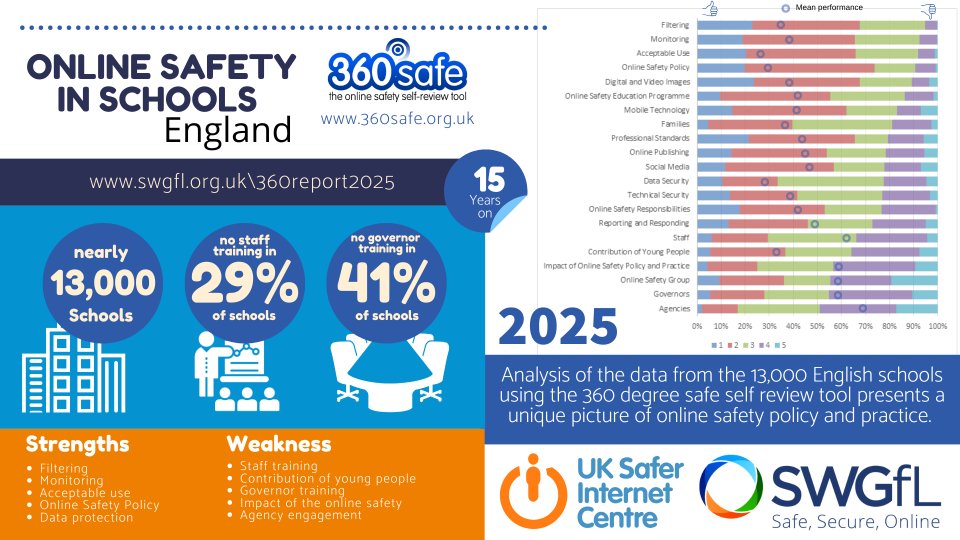This report presents the 2025 analysis of data from nearly 13,000 schools and colleges in England using the 360 Degree Safe self-review tool, which enables schools to assess, benchmark, and improve their online safety provision. Developed by SWGfL and launched in 2009, the tool covers 21 key aspects of digital safeguarding, from filtering and monitoring to staff training, leadership accountability, and community engagement, rated on a five-level maturity scale (5 = no provision, 1 = aspirational best practice).
Current performance shows that schools have made steady, measurable progress in strengthening their online safety frameworks. Technically driven and compliance-related areas, such as filtering, monitoring, acceptable use, online safety policies, and data protection, consistently score highest. These aspects reflect the impact of statutory duties, inspection frameworks, and national safeguarding expectations.
steady, measurable progress in strengthening their online safety frameworks. Technically driven and compliance-related areas, such as filtering, monitoring, acceptable use, online safety policies, and data protection, consistently score highest. These aspects reflect the impact of statutory duties, inspection frameworks, and national safeguarding expectations.
However, weaker areas persist, including governor training, staff development, external agency collaboration, and meaningful involvement of young people in shaping strategy. Nearly half of schools report limited engagement with external stakeholders, and 29% still lack basic staff training, despite statutory safeguarding requirements. These gaps highlight the need for stronger leadership focus and systematic scrutiny beyond inspection compliance.
A historical analysis of the data since the tool’s launch in 2009 reveals a remarkable cultural shift. Early adopters have shown significant improvement across all aspects, especially in leadership accountability, professional standards, and the safe use of mobile and social technologies. Differences between primary and secondary schools—once pronounced in areas such as social media, mobile technology, and technical security—have now narrowed considerably, with primary schools showing notable gains. Meanwhile, technical safeguards such as filtering and monitoring have remained strong but largely unchanged, suggesting the greatest progress has been in strategic and cultural development rather than technology alone.
Key findings:
- Almost 50% of England’s primary and secondary schools actively use the tool to review and improve online safety.
- Filtering (2.07), Online Safety Policy (2.11), Acceptable Use (2.17), and Monitoring (2.19) are the strongest performing areas.
- Agencies (3.31), Online Safety Group (3.13), Governors (3.11), and Impact of Policy (3.07) remain the weakest, indicating gaps in collaboration and oversight.
- The percentage of schools with no staff training dropped from over 70% in 2010 to under 10% in 2025, demonstrating sustained improvement over time.
Overall, the findings confirm that the 360 Degree Safe tool is an effective driver of school improvement and cultural change in digital safeguarding. To continue advancing, schools must now move beyond compliance-focused technical measures and invest in governor capability, staff development, parental engagement, and whole-community participation to create resilient, future-ready online safety cultures.
